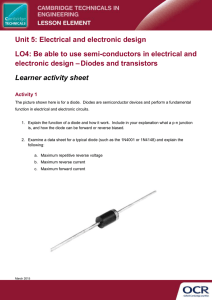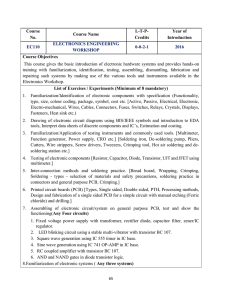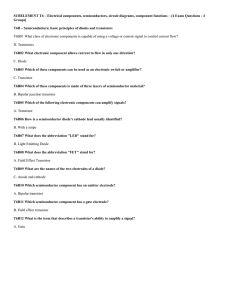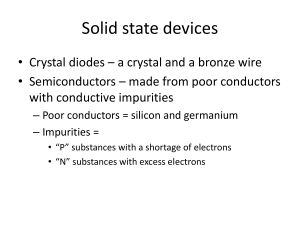ELectronics Workshop - Mehran University of Engineering
advertisement
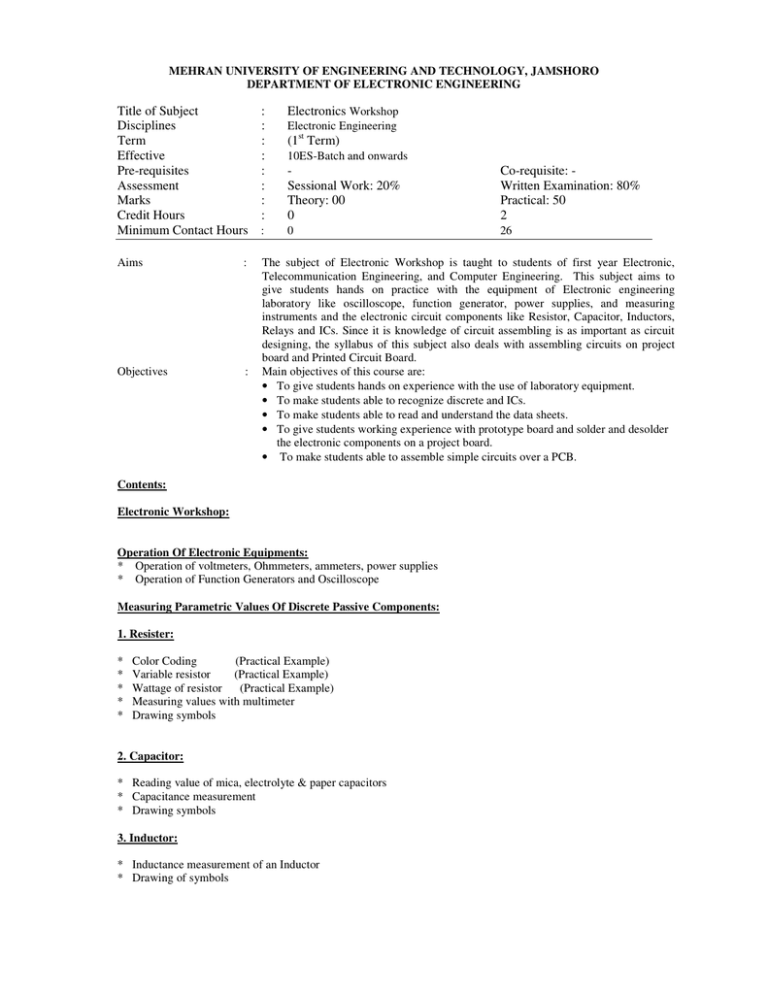
MEHRAN UNIVERSITY OF ENGINEERING AND TECHNOLOGY, JAMSHORO DEPARTMENT OF ELECTRONIC ENGINEERING Title of Subject : Disciplines : Term : Effective : Pre-requisites : Assessment : Marks : Credit Hours : Minimum Contact Hours : Aims : Objectives : Electronics Workshop Electronic Engineering (1st Term) 10ES-Batch and onwards Sessional Work: 20% Theory: 00 0 Co-requisite: Written Examination: 80% Practical: 50 2 0 26 The subject of Electronic Workshop is taught to students of first year Electronic, Telecommunication Engineering, and Computer Engineering. This subject aims to give students hands on practice with the equipment of Electronic engineering laboratory like oscilloscope, function generator, power supplies, and measuring instruments and the electronic circuit components like Resistor, Capacitor, Inductors, Relays and ICs. Since it is knowledge of circuit assembling is as important as circuit designing, the syllabus of this subject also deals with assembling circuits on project board and Printed Circuit Board. Main objectives of this course are: • To give students hands on experience with the use of laboratory equipment. • To make students able to recognize discrete and ICs. • To make students able to read and understand the data sheets. • To give students working experience with prototype board and solder and desolder the electronic components on a project board. • To make students able to assemble simple circuits over a PCB. Contents: Electronic Workshop: Operation Of Electronic Equipments: * Operation of voltmeters, Ohmmeters, ammeters, power supplies * Operation of Function Generators and Oscilloscope Measuring Parametric Values Of Discrete Passive Components: 1. Resister: * * * * * Color Coding (Practical Example) Variable resistor (Practical Example) Wattage of resistor (Practical Example) Measuring values with multimeter Drawing symbols 2. Capacitor: * Reading value of mica, electrolyte & paper capacitors * Capacitance measurement * Drawing symbols 3. Inductor: * Inductance measurement of an Inductor * Drawing of symbols Study Of Diode And Transistor Characteristics: 1. Diode: * * * * * Data sheet reading Analyzing diode characteristics on a curve tracer Finding a defective diode among a batch of non defective diode Various kinds of diode and their uses Drawing symbols 2. Transistor: * * * * * Data sheet reading Determining type (N&P) of an unknown bipolar transistor Labeling leads of an unknown transistor Analyzing transistor characteristics on a curve tracer Finding a defective transistor among a batch of non defective transistors * Various kinds of transistors and their uses * Drawing of symbols PCB (Printed Circuit Board): * * Assembling a simple circuit on a Bread Board Assembling and soldering components on a PCB (Kit Assembling) Mini Project * * On a PCB On a Bread Board Recommended Books: 1. Dr. B.S. Chowdhr & Ahsan A. Ursani, “The First Practical Book on Electronic Workshop”, published by Mehran Infotech Consultants, Hyderabad, 2. Paul Horowitz & Ian Robinson, "Laboratory Manual for Art of Electronics”, Cambridge University Press. 3. Bernard Grobe, "Basic Electronics". 4. Paul B. Znbar, Albert P. Malvino, "Basic Electronics Text Lab Manual", McGraw Hill. Approval: Board of Studies Board of FEEC Engineering Academic Council Res. No. 27.2 (a) Res. No. 5.5 (a) Res. No. 73.14 Dated: 22-08-2009 Dated: 18-12-2009 Dated: 09-01-2010
